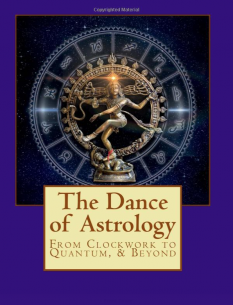
n the realm of philosophical writing, both logic and tradition suggest a lead-in to one’s magnum opus, some kind of “Prologue to Everything” to serve as an introduction. Douglas Egan isn’t much for tradition, and although he is quite logical, he dives right into the deep end with The Dance of Astrology. The book is lengthy by almost any standard, and seems all the more so in a world that is increasingly communicating via sound bites of 140 characters or less. Realizing the commitment it would require, The Dance of Astrology spent months under piles of other books, papers, and occasionally laundry, as I hesitated to begin investigating what it had to offer. “What if it’s awful,” I worried, almost as much as I feared it would be good. The Dance of Astrology is a tremendous book. Douglas Egan has written a most encompassing book on a worldview that supports astrology, and he has done it with stunning clarity. The reader is a good way into the book before discussion of astrology per se begins. Earlier sections are devoted to the topics of physics, consciousness, and synchronicity, and soon after the section devoted directly to astrology, Egan concludes with additional chapters on metaphysics. Yet those interested in astrology shouldn’t despair, as the author frequently shows the reader why potentially tangential topics are actually key to understanding astrology in the contemporary world.
Egan avoids the simplistic explanations that crowd much of New Age thinking. For example, we can look at the section on physics. Many authors have already explained how the Newtonian, mechanical view of physics has been replaced by the more indeterminate, quirky (or is it quarky?) understanding of quantum mechanics. When I opened to the first chapters of this section, I was ready to cringe, expecting another proclamation that we have free will because the state of electrons is indeterminate – I’ve read and heard this curious and unsatisfying argument dozens of times. Instead, Egan notes that the implications of quantum mechanics for our macro-level world are quite uncertain, but recognizes that they present a suggestive as-if for levels of reality beyond the quantum level. He explains the conflicting views within the physics community itself, and does so in a way that illuminates an area that can seem hopelessly dense for the non-physicist (and he avoids the condescending analogies that are often used to explain physics to the rest of us). The section on consciousness follows, and Egan deals with this slippery issue with similar deftness. He ranges from the question of what consciousness is to psychic phenomena, again explaining a complex topic in a way that is accessible. Unlike physics, this is an area with which your reviewer is very familiar, and I have to say that this section of the book is an exceptionally well-written guide to contemporary thought and issues within the subject.
Synchronicity is a favorite concept among astrologers, in part because Jung’s coinage of the term helped to show his support for astrology. Yet Jung described a phenomenon, and only hinted at the mechanism by which it might work. The many books on synchronicity tend to do the same, pointing to some connection between the worlds of internal experience and external events. Egan also travels into this territory, with his usual clarity, and then begins to expand our understanding by placing an emphasis on the emotional tone of synchronistic experiences. While it is well known the synchronicities (and psychic occurrences) tend to happen around areas with a strong emotional charge, Egan’s speculations about this process are more in-depth than many authors’. He is also open about his own experiences, something that helps us to connect with his ideas about emotional content on an emotional level. When he arrives at the subject of astrology, Egan continues the approach he’s used earlier in the book. The Dance of Astrology is about astrology, but it’s not a textbook. Rather, his thoughtful essays help to place astrology within the wider context he has developed in the prior topics. He discusses topics such as secondary progressions as an argument in favor of a symbolic rather than material understanding of astrology, and even has an essay suggesting why it would be good for young people to learn astrology. He then goes on to explore greater possibilities in the section on metaphysics. Given the range and weight of his subject matter, the reader might expect the tone of the book to be pedantic and dry, but Egan writes in a casual, approachable way that makes for a very pleasant read. He is frequently personal, bringing in experiences from his own life, but never gets folksy. The one criticism I have is that in his determination not to write a scholarly work, he missed an opportunity to write a great one – a few endnotes would go a long way. On the other hand, the author does provide us with a large reading list so that we can do our own researches. It’s a big book, but don’t be intimidated. Readers anywhere from cold novices to established astrologers can read and enjoy The Dance of Astrology. It’s a book that many, many people should read, as it shows why astrology is in concert with an emerging paradigm.